Kristine Hughes's Blog, page 70
September 23, 2015
WATERLOO WEDNESDAY: VICTORIA'S RANT ON THE SMITHSONIAN ON WATERLOO
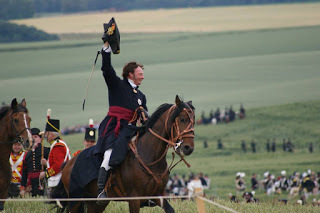 from the reenactment in 2015
from the reenactment in 2015On the cover of the June 2015 issue of the Smithsonian Magazine I found this Tease: Napoleon's Last Charge: Why Waterloo should never have been fought.
Here was the challenge in the headline of the article on p. 66: "Napoleon's Last Charge; On the bicentennial of the most famous battle in world history, a distinguished historian argues that Waterloo never should have been fought."
Om the website, the copy of the article is headlined: "Why We'd Be Better Off if Napoleon Never Lost at Waterloo". To read the article, click here. You'll get an ad, but click on the upper right to go straight to the story.
Provocative. Controversial. Shabby. Maybe insulting. Surely irritating to Victoria. and I assume Kristine. So understand, dear reader, that my teeth were on edge before I read a word of the story.
It takes eight paragraphs for the author to stop reciting the details of Napoleon's defeat and ask the headline questions: "Why was the Battle of Waterloo even fought? Was it really necessary to the peace and security of Europe?"
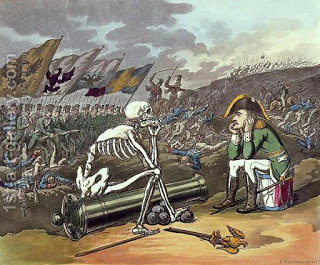 Whose fault was it?
Whose fault was it?To reach an examination of the author's answer, read another eighteen or so long paragraphs, ignoring for the moment the claim of Napoleon's innocence of any previous provocation in the twenty-some years of carnage ("Napoleon started none of those wars; but he won all of them" -- REALLY??).
The author quotes Napoleon's message to the Allied Powers, including the representative of the legitimate current ruler of France, Louis XVIII: "...from now on it will be more pleasant to know no other rivalry than that of the benefits of peace..."
The author writes; "The foremost motive that the British, Austrians, Prussians, Russians and lesser powers publicly gave for declaring war was that Napoleon couldn't be trusted to keep the peace." Seems they knew Napoleon better than he knew himself.
The author then makes several claims about what Napoleon wanted now -- that the leopard had changed his spots and now was content with peaceful aims for France. Which begs the question -- did the Allies declare war on Napoleon? They indeed declared him an outlaw. But who was assembling an army, putting armament manufacturers and tailors to work forging cannons and creating musket, outfitting the army splendidly...was this for the purpose of peace? Napoleon did this as the Allies cobbled together their troops. Which came first, the chicken or the egg??
Talk about revisionist history! What nonsense.
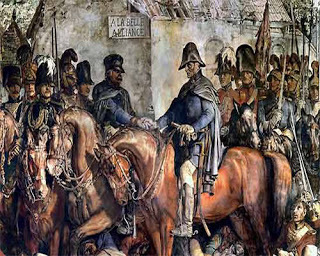 Daniel Maclise's version of the meeting after the battle of Blucher and Wellington
Daniel Maclise's version of the meeting after the battle of Blucher and WellingtonFrom the perspective of 200 years later, we do indeed see that the eventual settlement of European borders and governments was reactionary, repressing the ideals of liberty and equality, of representative powers for the masses. Those were the ideals Napoleon claimed to represent, but when you see what he DID and not what he merely said, what hollow words he uttered. How could anyone with the responsibility for the welfare of many peoples and nations believe that the returned emperor of the French would be satisfied with peace?
The author of the Smithsonian Magazine article is Andrew Roberts, who has written many books on the great characters in history, including most recently Napoleon: A Life. If you can tolerate a rather smug interviewee, click here for a segment by Charlie Rose. Again, I regret you will probably have to endure an ad.
In this interview, and in his book Waterloo: The Battle for Modern Europe (Harper Perennial, 2005) Roberts made no claim that Waterloo should not have been fought at all. In the interview, he affirms that Napoleon was indeed guilty of war crimes -- if indeed marching large armies into neighboring countries for a dozen years was not fact enough to cause the Allies to doubt his newly-proclaimed dedication to peace in 1815.
It certainly appears to me, that whatever the claims to peaceful intentions, the army that crossed the border from France into the Kingdom of the Netherlands was that of Napoleon.
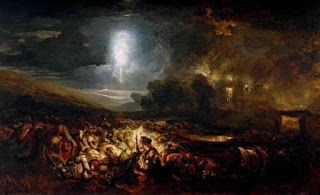 After the Battle, by J.M.W. Turner
After the Battle, by J.M.W. TurnerAs for the claim that Napoleon didn't start any of his battles, I believe it is already obvious without further elaboration that one should laugh off this ridiculous claim.
Smithsonian Magazine -- for shame! Andrew Roberts - what were you thinking? I guess I thought better of both the author and the magazine. I didn't think they would stoop to such obvious baiting and taunting the reader -- seems a cheap way of enticing readership. Next month, they could do an article comparing Josephine to whats-her-name Kardashian. Pure trashiness again.
Humbug!!
Click here for a more reasonable approach.
By the way, I sent a shorter version of this message to Smithsonian magazine but in the July issue they published others. One was a paen to Roberts' faulty views, praising Napoleon's "progressive politics" while the other found Roberts' "admiration for Napoleon is far too rosy." Gee, how insightful.
What do you think? Do you think the Allies should have trusted Napoleon not to attack ever again and stay within French borders? Or were they wise to prepare to defeat him once and for all?
Published on September 23, 2015 08:06
September 20, 2015
DO YOU GET BOOKS?

Author Eileen Dreyer posted this on her Facebook page recently. I commented that this was especially apropos, as I've recently taken all the books down from my library because I'm having built-in bookcases done this week. There are boxes of books in storage and piles of books scattered all around my home.

No chance of my being murdered in my bed, as it's virtually surrounded by books.

I think the front door is sufficiently booby trapped.

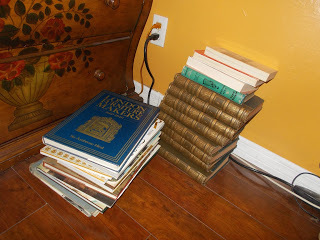

Which brings us to the title of this post - Do You Get Books? If you're a voracious reader, an author, historian or a bibliophile, then you get books. I get books. Hubby does not get books.
"Do you really need all these books? Can't you weed out some of them?"
"Yes. No."
Honestly, get rid of them? They're like children. How would one decide? Why should one have to?
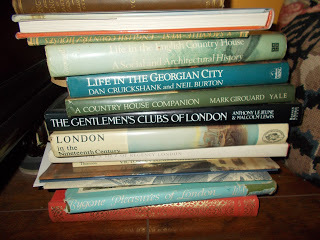
Then there are the people who have no conception of what a specialist library is. I told a friend that I had to empty out my bookshelves and that it was a massive job as I have over 600 books.
"Yeah," she said. "I have alot of paperbacks, too."
"No, no. These are reference books. Hardback. Some from the 19th century."
"Oh," she said. "Maybe you could give some to Goodwill."
Sigh. Obviously, she doesn't get books.
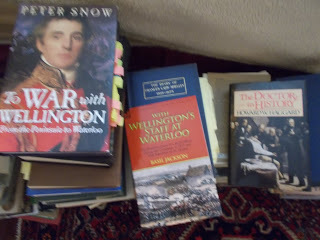
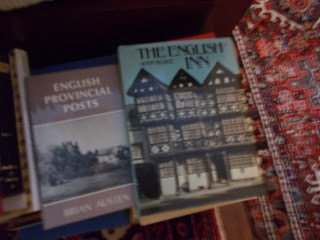
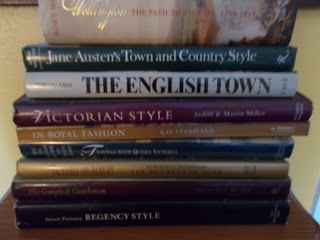
Personally, I need to live surrounded by books. I refer to them. I re-read them. I browse them. I like to look at them. I love them. And the odd antique. Like my Victorian stuffed pheasant.

Strangely, Hubby has never complained about the pheasant.

He does complain about my 'hoarding.'
"You're a hoarder."
"How can you say that? I'm not a hoarder."
"Look at all these books. Hoarding."
"No, it's a collection of books, otherwise known as a library."
"Hoarder."
"Library."
"Hoarder."
Do you get books? If so, do leave me a comment. Preferably something pithy that I will be able to use against Hubby when next we argue about my books. And we will.
Published on September 20, 2015 23:30
September 18, 2015
THE DUKE OF WELLINGTON TOUR: THE REGENCY TOWN HOUSE
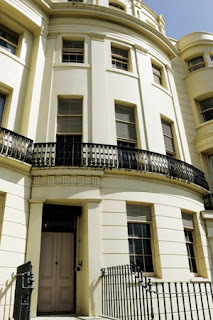
I first visited the Regency Town House about a decade ago, when the restoration project was just getting under way under the guidance of Nick Tyson. The Grade I listed terraced home of the mid-1820s is being developed as a heritage centre and museum to focus on the architecture and social history of Brighton & Hove between the 1780s and 1840s. The Project encompasses so much more than the house itself. In addition to restoring two townhouses, the Project is also delving into the social history of Regency Brighton and Hove. Links on their website will allow you to see who lived in Brighton and Hove at the time and to explore the Bevan and Dewar Letters, which have been transcribed and which give insight into daily and family life in the area from 1824 to 1870. To visit the website of the Regency Town House, click here.
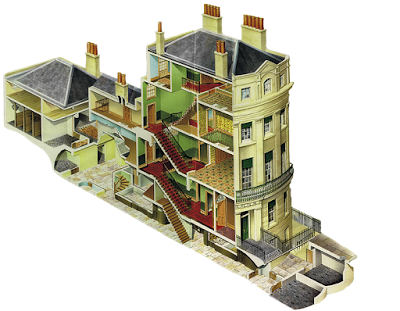
When I knew that the Duke of Wellington Tour would be visiting Brighton as one of it's stops, I knew that Victoria and I had to include another visit to the Town House for our group to experience this unique project first hand. From the website:
The Regency Town House was built on what had already become the traditional layout for town houses. The domestic offices for the servants were in the basement, the formal rooms were on the ground and first floors and the bedrooms on the floors above. Due to higher land prices in towns, even large houses tended to be built upwards on long, narrow plots. At the back of the house there was a coach house, stable block and quarters for the coachmen and grooms.
If you think that ten years is a rather long time for the restoration to be ongoing, you should keep in mind that the aim is to restore the entire structure, inside and out, to its Regency state. This means work being undertaken by historians and architectural restorers, painters, masons, roofers, carpenters, tilers, etc., etc. all of whom are using traditional building methods and materials. It also means that the costs can sky rocket depending on the phase of work and unfortunately, the Project is often put on hold as new funds are found or raised in order for the work to continue.
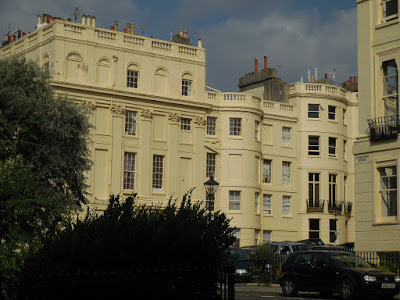
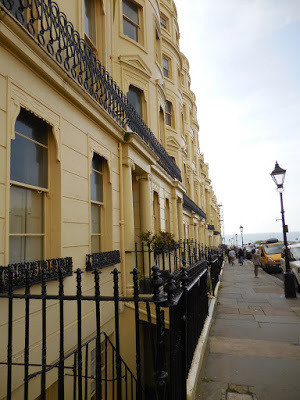
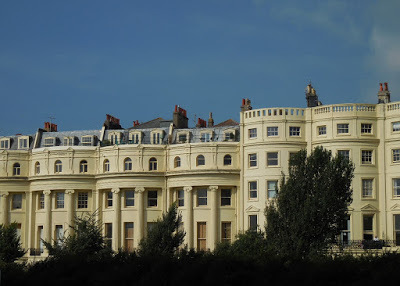
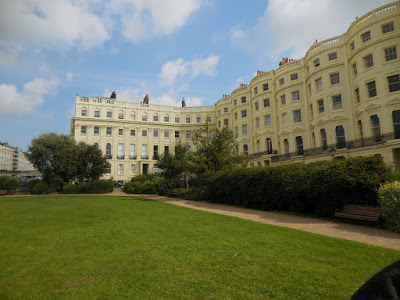
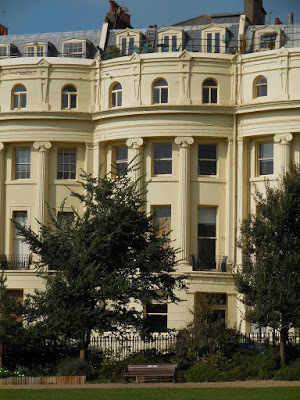
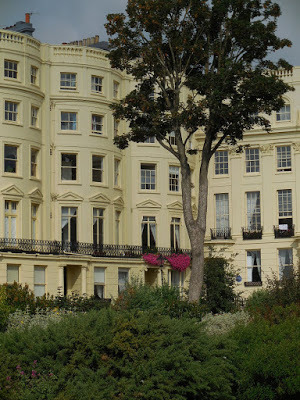
Our group was fortunate enough to be given a private tour by Nick Tyson himself, and the day began outside in the Square, where Nick explained the Project and described for us what life was like in Hove during the Regency period.
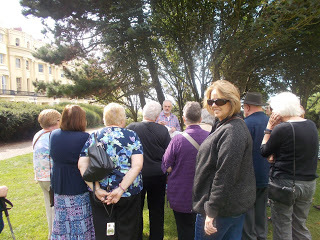
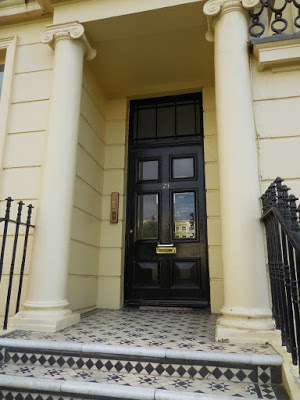
Once inside, Nick explained the scope of work that has been ongoing and pointed out, and elaborated upon, many of the architectural details of the period. The background on these was fascinating.
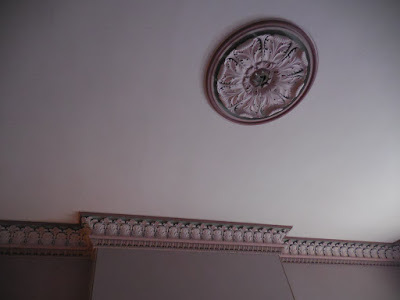
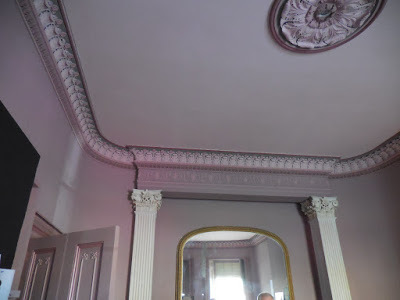

Nick also pointed out the methods that were used to sand down the painted walls so that each individual layer of paint could be analysed and dated.
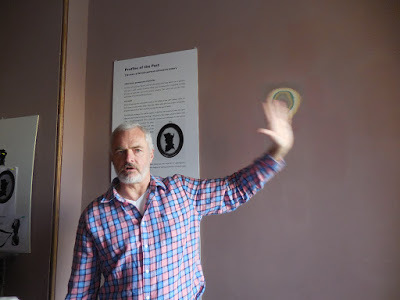
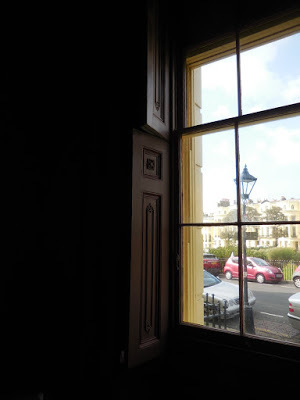
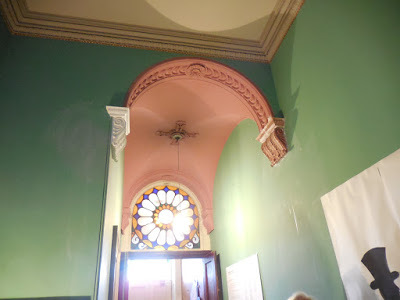
Many were surprised to learn that Regency paint colours ran the gamut from subdued to bold.
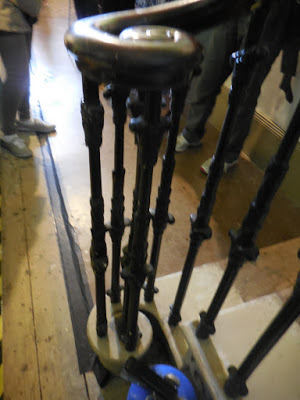
We were given an insight into period joinery and carpentry skills, as well as a primer on methods and materials that would have been common to the area.
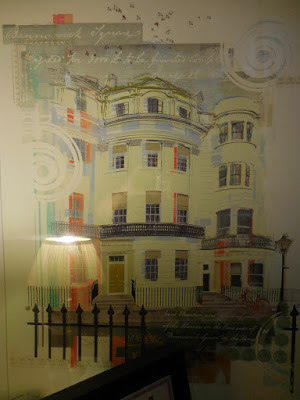
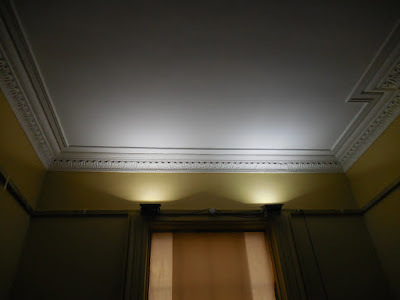
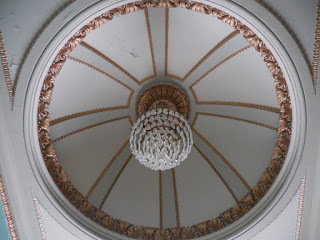
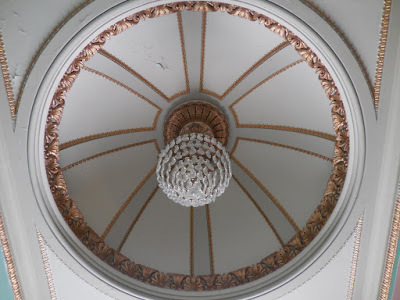
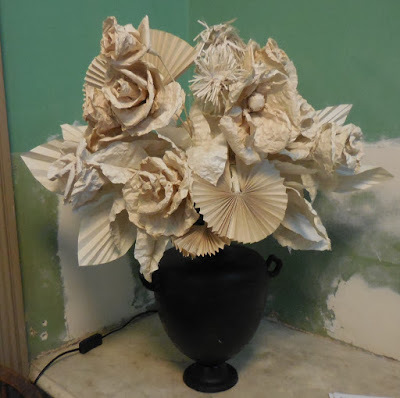
The Town House also curates a collection of period silhouettes, which were on display during our visit alongside a temporary exhibit of historic costumes.
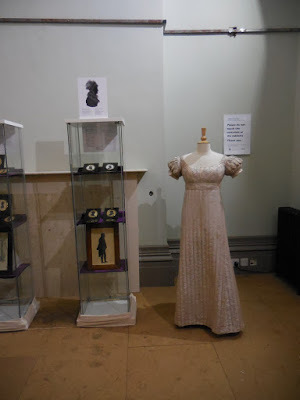
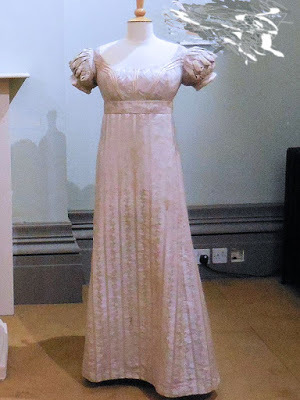
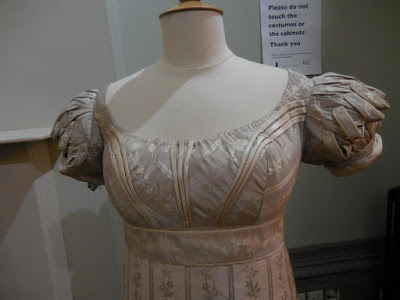
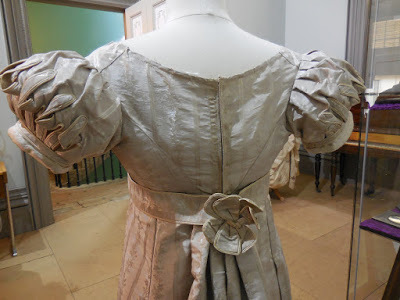
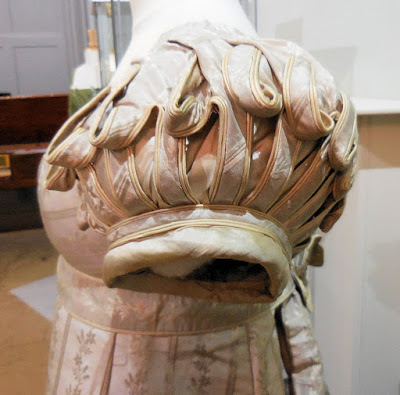
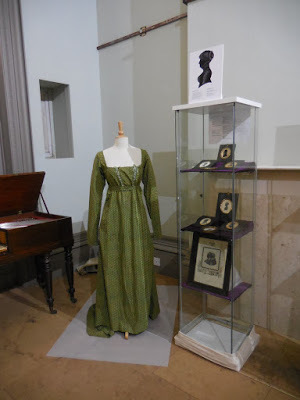
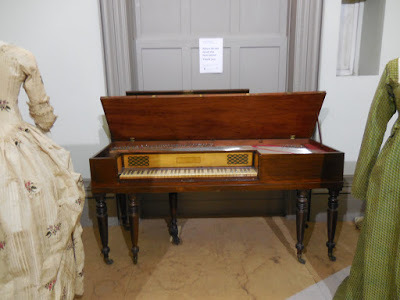
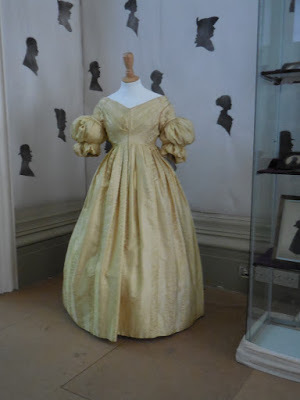
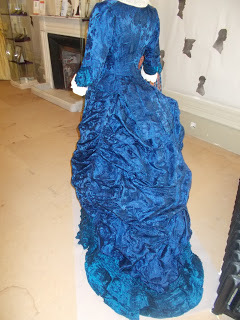
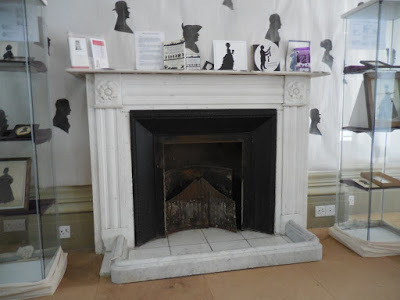
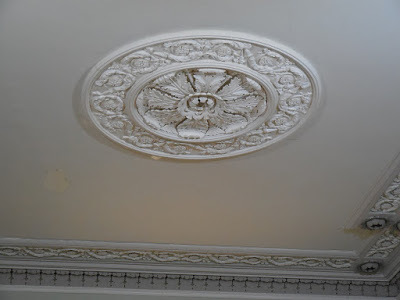
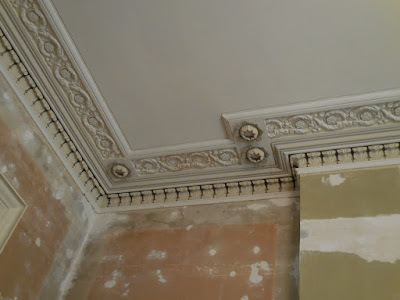
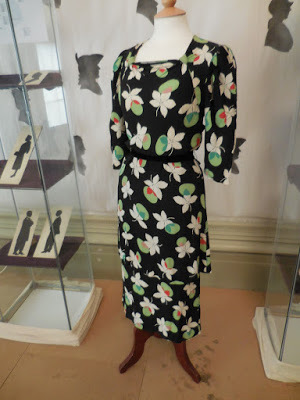
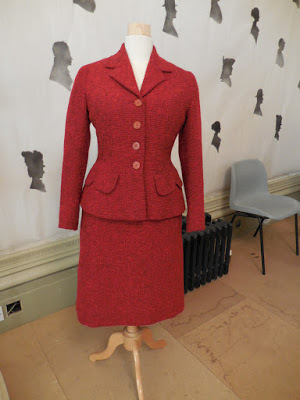
By purchasing the neighboring town house at No. 10, the Project was able to add authentic, basement domestic offices and rooms to it's collection. We had to opportunity to explore these areas, most of which are still in their original states. You can read more about the servant's quarters and domestic rooms at the Town House by clicking here.
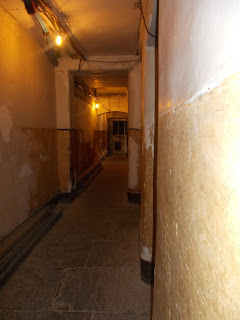

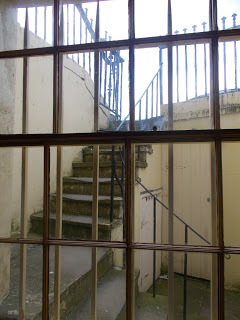
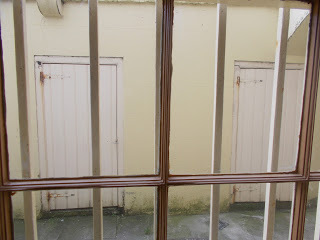
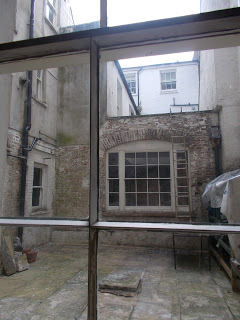


Honestly, we could have stayed for the entire day and never grown tired of listening to Nick explain elements of the Town House and period daily life. He is a font of knowledge, a born storyteller and his passion for the Project is catching. Number One London is seriously thinking about planning a tour centered around the Regency period, the Town House and Brighton as a Royal destination that would include tours and seminars by experts in various fields.
For an online tour of the Regency Townhouse, click here.
You can follow the restoration projects and other events at the Regency Townhouse at their Facebook page, here.
For a 360 degree street view of Brunswick Square, click Google Maps here.
Published on September 18, 2015 00:30
September 16, 2015
WATERLOO WEDNESDAY: THE MONUMENTS MEN OF 1815
MONUMENTS MEN OF 1815
After the 2014 film The Monuments Men (starring George Clooney and Matt Damon), attention focused on the return of many art objects to their original homes after their looting by Nazi troops. Even more attention arose after the story of the Woman in Gold, starring Helen Mirren, about the return of the 1907 Klimt painting in 2006.
 Portrait of Adele Bloch-Bauer by Gustav Klimt, 1907Neue Galerie, NYC
Portrait of Adele Bloch-Bauer by Gustav Klimt, 1907Neue Galerie, NYC
The Nazis were hardly the first victorious troops to steal great cultural artifacts from subjugated societies. It certainly was usual, even expected, to find treasures from a conquered people in the hands of their conquerors. But one might say Napoleon Bonaparte helped himself to more than had been usual when he confiscated many works of art in Europe and Egypt.
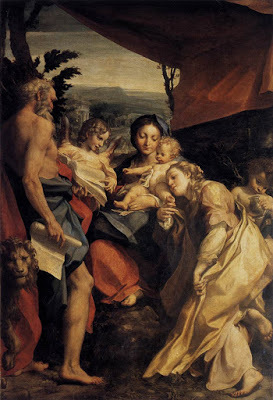 Madonna di San GerolamoGaleria Nazionale Parma
Madonna di San GerolamoGaleria Nazionale Parma
Napoleon's troops, or perhaps the future emperor himself, confiscated this treasured work of Antonio Allegri, known as Correggio, during the French occupation of Italy. Returned to Italy in 1815, it can be seen in Parma's national gallery. It was originally painted as an altarpiece in the 1520's for a chapel in Parma's Church of Sant'Antonio Abate.
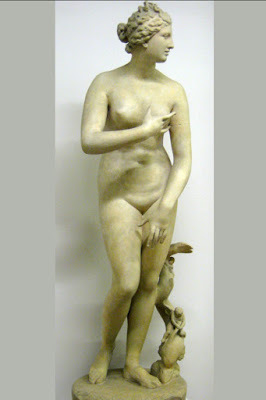 Venus d'Medici, Uffizzi Gallery
Venus d'Medici, Uffizzi Gallery
This famous work in marble, often copied, was found in Rome, a Hellenistic copy of a Greek statue of Aphrodite in the tradition of Praxiteles. After reservations about its possible lewdness, one of the popes sent it to Florence where it was admired by many travelers and written about by Lord Byron in Childe Harolde. In 1800, the statue was shipped to Palermo to protect it from Napoleon. But eventually the French pounced, and it was indeed taken to Paris. It was returned to Florence in December, 1815 and can be viewed today in the Uffizzi Gallery. Reproductions can be seen in many museums, including the Boston Athenaeum, the Getty Museum in California, and the Hermitage in St. Petersburg, Russia.
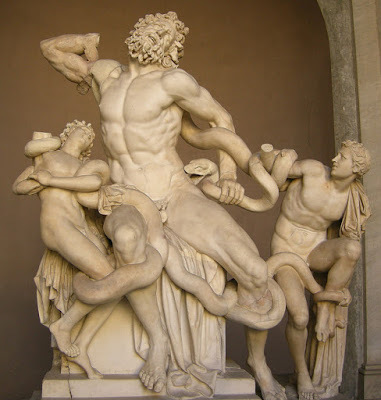 Laocoon and His Sons
Laocoon and His Sons
The group of tortured marble figures was discovered in Rome in 1506 and may have been once praised by Pliny the Elder. It portrays the Trojan priest Laocoon and his two sons attacked by sea monsters. Pope Julian II called on Michelangelo to assess the statue and it was soon placed on public view at the Vatican. The French took it to Paris for display at the Louvre in 1798. It was returned to Rome in 1816 and can be seen today in the Vatican Museum.
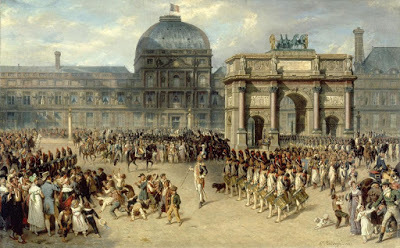 Military Review at the Tuileries, 1810, by Hippolyte Bellange.
Military Review at the Tuileries, 1810, by Hippolyte Bellange.
Napoleon's troops also seized the Quadriga, four horses from the front of St. Mark's in Venice and brought it to Paris where it was placed on top pf the Arc de Triomphe du Carrousel, built to commemorate Napoleon's triumphs.
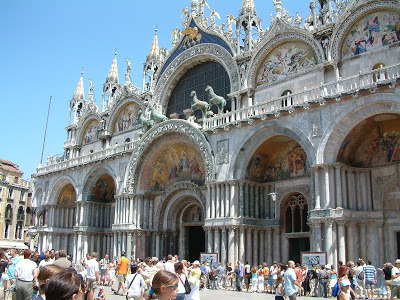 Basilica of San Marco, Venice The Venetians had stolen the figures from Istanbul in the 13th century; nevertheless, the Quadriga was returned to Venice in 1815.
Basilica of San Marco, Venice The Venetians had stolen the figures from Istanbul in the 13th century; nevertheless, the Quadriga was returned to Venice in 1815.
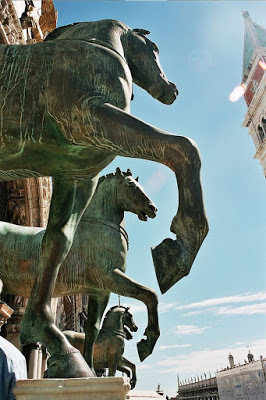 Replicas atop St. Mark's Basilica in Venice
Replicas atop St. Mark's Basilica in Venice
Due to the effects of air pollution on the statue, the "original" is now in a museum. A replica replaces it on St. Mark's.
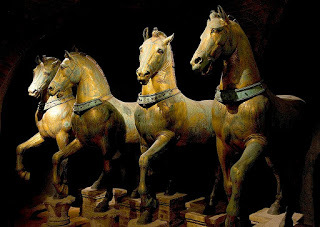 Basilica of San Marco horses inside in the museum
Basilica of San Marco horses inside in the museum
The title Quadriga is derived form the Latin words for 'four' and 'yoke'. As originally sculpted by the or the Greeks, statues of four horses drawing a chariot with a triumphal figure, usually depicting peace, can frequently be found on monumental arches.
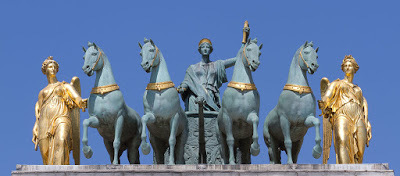 Peace riding in a triumphal chariot, by Francois-Joseph Bosio (1828).
Peace riding in a triumphal chariot, by Francois-Joseph Bosio (1828).
Above is the Quadriga created for the Arc de Triomphe du Carrousel, Paris, to replace the Venetian version. This one was "in honor" of the restoration of the Bourbon monarchy to France after Napoleon.
 The Brandenburg Gate, Berlin
The Brandenburg Gate, Berlin
The famous Brandenburg Gate, built in the reign of Frederick William of Prussia, was constructed by Carl Gotthard Langhans from 1788 to 1791. Shortly thereafter it was crowned by a Quadriga of Victory by Johann Gottfried Schadow. In 1806, the Quadriga was stolen by Napoleon and taken to Paris. It was returned by Prussian General Gebhard von Blucher in 1814 after Napoleon's first exile.The Iron Cross added to the sculpture's laurel wreath of peace was an object of contention at various points in time, removed by East Germany but restored after German reunification in 1990.
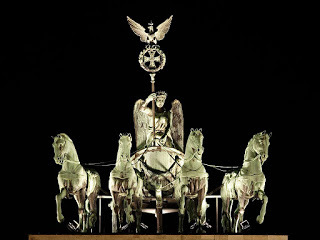 close-up of Brandenburg Gate Quadriga
close-up of Brandenburg Gate Quadriga
For a further account of the return of looted art and the men responsible, click here.
Napoleon's goal had been to bring the best of all of Europe's artwork to Paris and make the Louvre their home, a collection of the very best in one place -- of Napoleon's choosing.
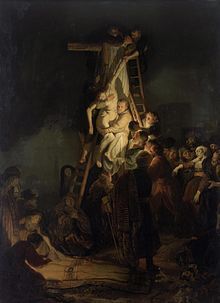 Descent from the Cross by Rembrandt
Descent from the Cross by Rembrandt
Many works were not returned. Descent from the Cross was taken from the German State of Hesse-Kessel in 1806 by the French, purchased by Empress Josephine, who sold it to the Tsar. It remains in the Hermitage, St. Petersburg.
Some of the items commandeered by Napoleon's men ended up in England. One of the most important is the Rosetta Stone, now in the British Museum, London. It was found near the city of Rosetta in Egypt in 1799 by French soldiers and turned over to some of the many scholars accompanying the French forces. After the British defeat of the French in Egypt in 1801, the stone and other artifacts were sent to London and have been displayed in the British Museum since 1802. Plaster casts of the stone were made and distributed to scholars. On the stone is inscribed a decree in three languages which became the key to unlocking the translation of ancient Egyptian hieroglyphics.
 Rosetta Stone
Rosetta Stone
London's Wellington Museum in Apsley House is the home of many fine paintings stolen from museums in Madrid by Napoleon's brother and puppet king of Spain, Joseph Bonaparte. When the Duke of Wellington's forces overran the French troops at the Battle of Vitoria in June, 1813, Joseph escaped but left behind his baggage train containing hundreds of artworks he had looted. The Duke rescued the works and sent them to London for preservation from the war in the Peninsula. Under the care of the Duke's brother, the works were preserved and re-framed. After the war when Spanish King Ferdinand VII was restored to his throne, Wellington offered to return the works to Madrid. Instead, in thanks for the Duke's efforts on behalf of the Spanish people, the King gave a significant number of the artworks to the Duke. Many now hang in Apsley House, London. Here are a few examples.
 The Agony in the Garden, c.1524by Antonio Allegri, known as Correggio, 1489-1534
The Agony in the Garden, c.1524by Antonio Allegri, known as Correggio, 1489-1534
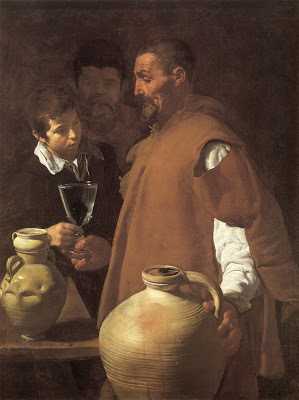 The Water-Seller of Seville, 1618-22by Diego Velazquez, (1599-1660)
The Water-Seller of Seville, 1618-22by Diego Velazquez, (1599-1660)
Three canvasses formerly attributed to Titian's studio were recently cleaned and conserved, revealing them to be the actual work of Titian himself. For a guide to these three paintings, click here.
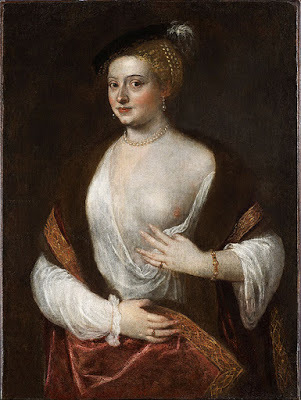 Titian's Mistress, 1550-60
Titian's Mistress, 1550-60
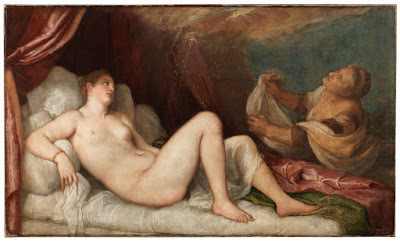 Danae, 1551-53Tiziano Vecelli, known as Titian, 1490-1576, Venetian School
Danae, 1551-53Tiziano Vecelli, known as Titian, 1490-1576, Venetian School
One painting the Louvre got to keep was a huge altarpiece from Venice.
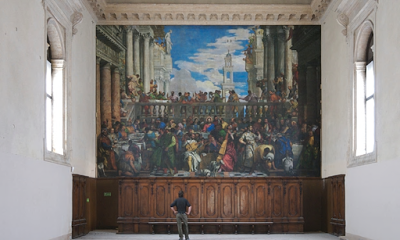 The Wedding at Cana, 1563, by Paolo Veronese
The Wedding at Cana, 1563, by Paolo Veronese
Designed for the monastery of San Giorgio Maggiore in Venice, Napoleon had this vast work shipped to Paris in 1797 and hung in a special gallery in the Louvre. It was considered too large to be returned, so it can be seen there today.
Many of the world's great museums are replete with art stolen, confiscated, even purchased from distant cultures. Conquering forces still loot, though some try to protect great artworks. Some only destroy. Ars longa, vita brevis.
After the 2014 film The Monuments Men (starring George Clooney and Matt Damon), attention focused on the return of many art objects to their original homes after their looting by Nazi troops. Even more attention arose after the story of the Woman in Gold, starring Helen Mirren, about the return of the 1907 Klimt painting in 2006.
 Portrait of Adele Bloch-Bauer by Gustav Klimt, 1907Neue Galerie, NYC
Portrait of Adele Bloch-Bauer by Gustav Klimt, 1907Neue Galerie, NYCThe Nazis were hardly the first victorious troops to steal great cultural artifacts from subjugated societies. It certainly was usual, even expected, to find treasures from a conquered people in the hands of their conquerors. But one might say Napoleon Bonaparte helped himself to more than had been usual when he confiscated many works of art in Europe and Egypt.
 Madonna di San GerolamoGaleria Nazionale Parma
Madonna di San GerolamoGaleria Nazionale ParmaNapoleon's troops, or perhaps the future emperor himself, confiscated this treasured work of Antonio Allegri, known as Correggio, during the French occupation of Italy. Returned to Italy in 1815, it can be seen in Parma's national gallery. It was originally painted as an altarpiece in the 1520's for a chapel in Parma's Church of Sant'Antonio Abate.
 Venus d'Medici, Uffizzi Gallery
Venus d'Medici, Uffizzi GalleryThis famous work in marble, often copied, was found in Rome, a Hellenistic copy of a Greek statue of Aphrodite in the tradition of Praxiteles. After reservations about its possible lewdness, one of the popes sent it to Florence where it was admired by many travelers and written about by Lord Byron in Childe Harolde. In 1800, the statue was shipped to Palermo to protect it from Napoleon. But eventually the French pounced, and it was indeed taken to Paris. It was returned to Florence in December, 1815 and can be viewed today in the Uffizzi Gallery. Reproductions can be seen in many museums, including the Boston Athenaeum, the Getty Museum in California, and the Hermitage in St. Petersburg, Russia.
 Laocoon and His Sons
Laocoon and His SonsThe group of tortured marble figures was discovered in Rome in 1506 and may have been once praised by Pliny the Elder. It portrays the Trojan priest Laocoon and his two sons attacked by sea monsters. Pope Julian II called on Michelangelo to assess the statue and it was soon placed on public view at the Vatican. The French took it to Paris for display at the Louvre in 1798. It was returned to Rome in 1816 and can be seen today in the Vatican Museum.
 Military Review at the Tuileries, 1810, by Hippolyte Bellange.
Military Review at the Tuileries, 1810, by Hippolyte Bellange.Napoleon's troops also seized the Quadriga, four horses from the front of St. Mark's in Venice and brought it to Paris where it was placed on top pf the Arc de Triomphe du Carrousel, built to commemorate Napoleon's triumphs.
 Basilica of San Marco, Venice The Venetians had stolen the figures from Istanbul in the 13th century; nevertheless, the Quadriga was returned to Venice in 1815.
Basilica of San Marco, Venice The Venetians had stolen the figures from Istanbul in the 13th century; nevertheless, the Quadriga was returned to Venice in 1815. Replicas atop St. Mark's Basilica in Venice
Replicas atop St. Mark's Basilica in VeniceDue to the effects of air pollution on the statue, the "original" is now in a museum. A replica replaces it on St. Mark's.
 Basilica of San Marco horses inside in the museum
Basilica of San Marco horses inside in the museumThe title Quadriga is derived form the Latin words for 'four' and 'yoke'. As originally sculpted by the or the Greeks, statues of four horses drawing a chariot with a triumphal figure, usually depicting peace, can frequently be found on monumental arches.
 Peace riding in a triumphal chariot, by Francois-Joseph Bosio (1828).
Peace riding in a triumphal chariot, by Francois-Joseph Bosio (1828).Above is the Quadriga created for the Arc de Triomphe du Carrousel, Paris, to replace the Venetian version. This one was "in honor" of the restoration of the Bourbon monarchy to France after Napoleon.
 The Brandenburg Gate, Berlin
The Brandenburg Gate, BerlinThe famous Brandenburg Gate, built in the reign of Frederick William of Prussia, was constructed by Carl Gotthard Langhans from 1788 to 1791. Shortly thereafter it was crowned by a Quadriga of Victory by Johann Gottfried Schadow. In 1806, the Quadriga was stolen by Napoleon and taken to Paris. It was returned by Prussian General Gebhard von Blucher in 1814 after Napoleon's first exile.The Iron Cross added to the sculpture's laurel wreath of peace was an object of contention at various points in time, removed by East Germany but restored after German reunification in 1990.
 close-up of Brandenburg Gate Quadriga
close-up of Brandenburg Gate QuadrigaFor a further account of the return of looted art and the men responsible, click here.
Napoleon's goal had been to bring the best of all of Europe's artwork to Paris and make the Louvre their home, a collection of the very best in one place -- of Napoleon's choosing.
 Descent from the Cross by Rembrandt
Descent from the Cross by RembrandtMany works were not returned. Descent from the Cross was taken from the German State of Hesse-Kessel in 1806 by the French, purchased by Empress Josephine, who sold it to the Tsar. It remains in the Hermitage, St. Petersburg.
Some of the items commandeered by Napoleon's men ended up in England. One of the most important is the Rosetta Stone, now in the British Museum, London. It was found near the city of Rosetta in Egypt in 1799 by French soldiers and turned over to some of the many scholars accompanying the French forces. After the British defeat of the French in Egypt in 1801, the stone and other artifacts were sent to London and have been displayed in the British Museum since 1802. Plaster casts of the stone were made and distributed to scholars. On the stone is inscribed a decree in three languages which became the key to unlocking the translation of ancient Egyptian hieroglyphics.
 Rosetta Stone
Rosetta StoneLondon's Wellington Museum in Apsley House is the home of many fine paintings stolen from museums in Madrid by Napoleon's brother and puppet king of Spain, Joseph Bonaparte. When the Duke of Wellington's forces overran the French troops at the Battle of Vitoria in June, 1813, Joseph escaped but left behind his baggage train containing hundreds of artworks he had looted. The Duke rescued the works and sent them to London for preservation from the war in the Peninsula. Under the care of the Duke's brother, the works were preserved and re-framed. After the war when Spanish King Ferdinand VII was restored to his throne, Wellington offered to return the works to Madrid. Instead, in thanks for the Duke's efforts on behalf of the Spanish people, the King gave a significant number of the artworks to the Duke. Many now hang in Apsley House, London. Here are a few examples.
 The Agony in the Garden, c.1524by Antonio Allegri, known as Correggio, 1489-1534
The Agony in the Garden, c.1524by Antonio Allegri, known as Correggio, 1489-1534 The Water-Seller of Seville, 1618-22by Diego Velazquez, (1599-1660)
The Water-Seller of Seville, 1618-22by Diego Velazquez, (1599-1660)Three canvasses formerly attributed to Titian's studio were recently cleaned and conserved, revealing them to be the actual work of Titian himself. For a guide to these three paintings, click here.
 Titian's Mistress, 1550-60
Titian's Mistress, 1550-60 Danae, 1551-53Tiziano Vecelli, known as Titian, 1490-1576, Venetian School
Danae, 1551-53Tiziano Vecelli, known as Titian, 1490-1576, Venetian SchoolOne painting the Louvre got to keep was a huge altarpiece from Venice.
 The Wedding at Cana, 1563, by Paolo Veronese
The Wedding at Cana, 1563, by Paolo VeroneseDesigned for the monastery of San Giorgio Maggiore in Venice, Napoleon had this vast work shipped to Paris in 1797 and hung in a special gallery in the Louvre. It was considered too large to be returned, so it can be seen there today.
Many of the world's great museums are replete with art stolen, confiscated, even purchased from distant cultures. Conquering forces still loot, though some try to protect great artworks. Some only destroy. Ars longa, vita brevis.
Published on September 16, 2015 00:30
September 14, 2015
VISITING DOWNTON ABBEY COSTUMES AT AN "ENGLISH" COUNTRY HOUSE IN WISCONSIN
Victoria here, spending a hot and humid afternoon at this charming exhibition of costumes from the popular series Downton Abbey.
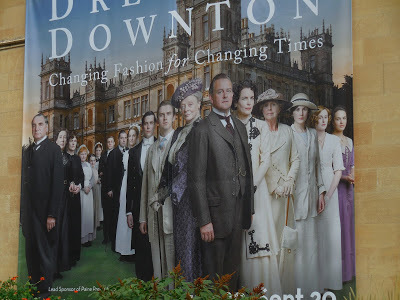 Huge Poster announcing the Exhibition
Huge Poster announcing the Exhibition
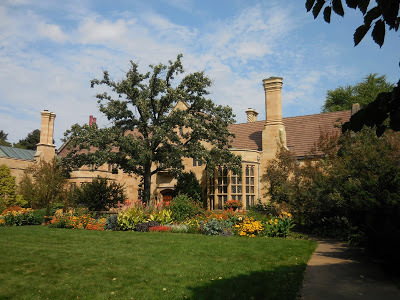 The Paines built their house to resemble a Jacobean English Manor.
The Paines built their house to resemble a Jacobean English Manor.
There was a healthy crowd at the Paine, probably among their largest. Most of the costumes were show in the rooms as illustrated in the pictures below, taken from various websites, as they allowed no interior photography.
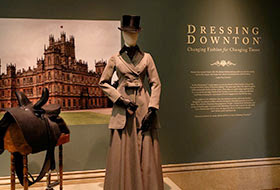 One of Lady Mary's riding habits, with her sidesaddle, in the gallery.
One of Lady Mary's riding habits, with her sidesaddle, in the gallery.
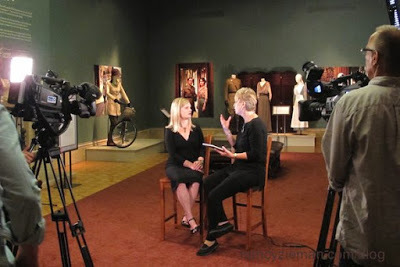 The gallery during taping of "Sewing With Nancy," a Wisconsin Public Television program; you can enjoy three six-minute segments. Click here for Daytime Wear; click here for Aristocratic Wear; and click here for Active Wear.
The gallery during taping of "Sewing With Nancy," a Wisconsin Public Television program; you can enjoy three six-minute segments. Click here for Daytime Wear; click here for Aristocratic Wear; and click here for Active Wear.
The Gallery was filled with costumes, all interesting, from the Edwardian through the WWI periods. The other costumes were shown in rooms of the house, a perfect setting. A few of the costumes were original antiques, some were fashioned with period fabrics and/or from period garments, and some were made with appropriate natural fabrics from scratch.
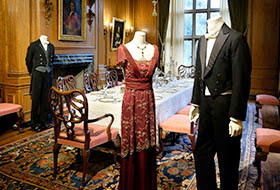 Evening Wear in the Dining Room, with a Footman in the background
Evening Wear in the Dining Room, with a Footman in the background
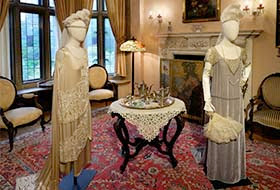 In one of the upstairs sitting rooms, the gowns worn in the 1925 scene of the Royal Drawing ?Room Presentation; Lady Rose on the left, Countess Grantham in grey on the right.
In one of the upstairs sitting rooms, the gowns worn in the 1925 scene of the Royal Drawing ?Room Presentation; Lady Rose on the left, Countess Grantham in grey on the right.
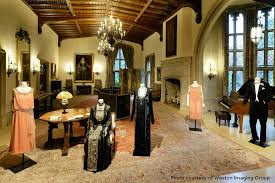 Evening Wear in the Great Room; the Dowager Countess wore the gown second from the left.
Evening Wear in the Great Room; the Dowager Countess wore the gown second from the left.
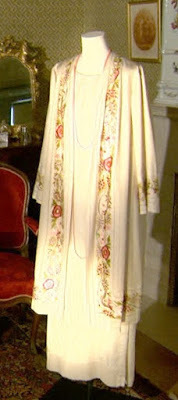 The Countess of Grantham's outfit for Edith's wedding, as shown at Biltmore
The Countess of Grantham's outfit for Edith's wedding, as shown at Biltmore
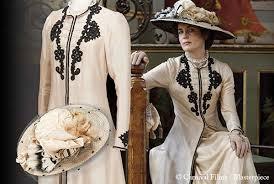 A beautifully detailed linen suit from the Edwardian period.
A beautifully detailed linen suit from the Edwardian period.
In all, 36 costumes are seen from DA's first four seasons, all made by Cosprop Ltd. with under the sponsorship of the program producers and local underwriters.
Even though it was unusually hot for Wisconsin, We wandered a bit in the garden, only slightly wilted by the heat. Both the blooms and the people! I snapped a few photos of the house and grounds.
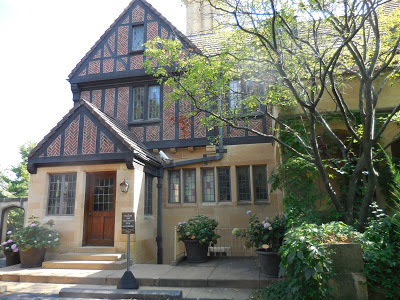 The kitchen entrance
The kitchen entrance
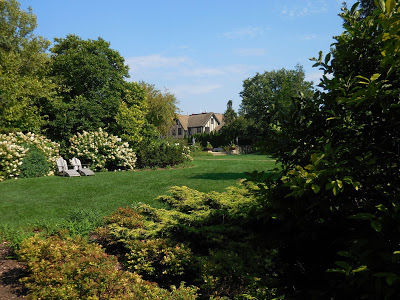 across the lawns to the coach house
across the lawns to the coach house
 the wilderness
the wilderness
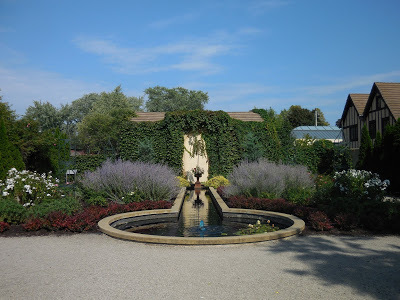 The lily pool
The lily pool
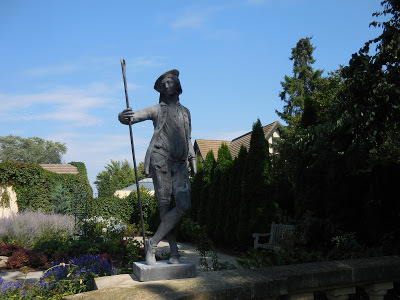 Statuary in the Garden, with the Coach House in the background
Statuary in the Garden, with the Coach House in the background
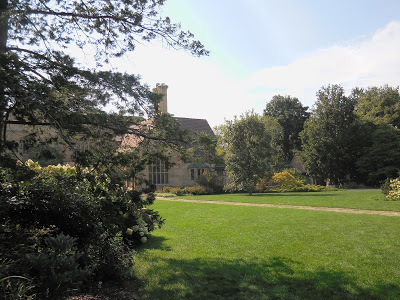 The house from the shade of the garden
The house from the shade of the garden
I regret that I waited so late in the Wisconsin showing of this exhibition as I would have preferred to see it several times and now I won't have time to go back before it ends on September 20, 2015. It had previously been shown at Winterthur in Delaware and at the Biltmore Mansion in North Carolina. Below is the upcoming schedule, so if there is a venue near you, you can share in the opportunity.
To see an account of the exhibition at Biltmore, click here.
Exhibition Tour ScheduleOshkosh, Wis.* Paine Art Center and Gardens June-September 2015Richmond, Va. Virginia Historical Society Oct. 2015-Jan. 2016Chicago, Ill. The Richard H. Driehaus Museum February-May 2016Cincinnati, Ohio Taft Museum of Art July-September 2016South Bend, Ind.The History MuseumOct. 2016-Jan. 2017Anaheim, Calif.Muzeo Museum and Cultural CenterFebruary-May 2017Nashville, Tenn.Cheekwood Art & GardensJune-September 2017St. Augustine, Fla.The Lightner MuseumOct. 2017-Jan. 2018
 Huge Poster announcing the Exhibition
Huge Poster announcing the Exhibition The Paines built their house to resemble a Jacobean English Manor.
The Paines built their house to resemble a Jacobean English Manor.There was a healthy crowd at the Paine, probably among their largest. Most of the costumes were show in the rooms as illustrated in the pictures below, taken from various websites, as they allowed no interior photography.
 One of Lady Mary's riding habits, with her sidesaddle, in the gallery.
One of Lady Mary's riding habits, with her sidesaddle, in the gallery. The gallery during taping of "Sewing With Nancy," a Wisconsin Public Television program; you can enjoy three six-minute segments. Click here for Daytime Wear; click here for Aristocratic Wear; and click here for Active Wear.
The gallery during taping of "Sewing With Nancy," a Wisconsin Public Television program; you can enjoy three six-minute segments. Click here for Daytime Wear; click here for Aristocratic Wear; and click here for Active Wear. The Gallery was filled with costumes, all interesting, from the Edwardian through the WWI periods. The other costumes were shown in rooms of the house, a perfect setting. A few of the costumes were original antiques, some were fashioned with period fabrics and/or from period garments, and some were made with appropriate natural fabrics from scratch.
 Evening Wear in the Dining Room, with a Footman in the background
Evening Wear in the Dining Room, with a Footman in the background In one of the upstairs sitting rooms, the gowns worn in the 1925 scene of the Royal Drawing ?Room Presentation; Lady Rose on the left, Countess Grantham in grey on the right.
In one of the upstairs sitting rooms, the gowns worn in the 1925 scene of the Royal Drawing ?Room Presentation; Lady Rose on the left, Countess Grantham in grey on the right. Evening Wear in the Great Room; the Dowager Countess wore the gown second from the left.
Evening Wear in the Great Room; the Dowager Countess wore the gown second from the left. The Countess of Grantham's outfit for Edith's wedding, as shown at Biltmore
The Countess of Grantham's outfit for Edith's wedding, as shown at Biltmore A beautifully detailed linen suit from the Edwardian period.
A beautifully detailed linen suit from the Edwardian period.In all, 36 costumes are seen from DA's first four seasons, all made by Cosprop Ltd. with under the sponsorship of the program producers and local underwriters.
Even though it was unusually hot for Wisconsin, We wandered a bit in the garden, only slightly wilted by the heat. Both the blooms and the people! I snapped a few photos of the house and grounds.
 The kitchen entrance
The kitchen entrance across the lawns to the coach house
across the lawns to the coach house the wilderness
the wilderness The lily pool
The lily pool  Statuary in the Garden, with the Coach House in the background
Statuary in the Garden, with the Coach House in the background The house from the shade of the garden
The house from the shade of the gardenI regret that I waited so late in the Wisconsin showing of this exhibition as I would have preferred to see it several times and now I won't have time to go back before it ends on September 20, 2015. It had previously been shown at Winterthur in Delaware and at the Biltmore Mansion in North Carolina. Below is the upcoming schedule, so if there is a venue near you, you can share in the opportunity.
To see an account of the exhibition at Biltmore, click here.
Exhibition Tour ScheduleOshkosh, Wis.* Paine Art Center and Gardens June-September 2015Richmond, Va. Virginia Historical Society Oct. 2015-Jan. 2016Chicago, Ill. The Richard H. Driehaus Museum February-May 2016Cincinnati, Ohio Taft Museum of Art July-September 2016South Bend, Ind.The History MuseumOct. 2016-Jan. 2017Anaheim, Calif.Muzeo Museum and Cultural CenterFebruary-May 2017Nashville, Tenn.Cheekwood Art & GardensJune-September 2017St. Augustine, Fla.The Lightner MuseumOct. 2017-Jan. 2018
Published on September 14, 2015 00:30
September 11, 2015
ONE YEAR AGO TODAY.... ON THE DUKE OF WELLINGTON TOUR
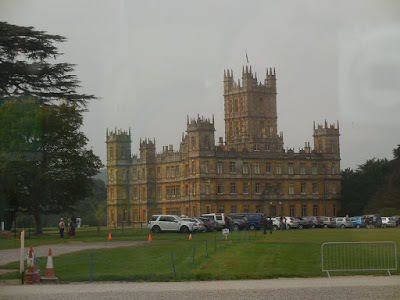 from the Car Park
from the Car ParkHere it is, September 11, 2015...exactly one year after the Duke of Wellington Tour visited Highclere Castle, perhaps better known as Downton Abbey. We were all fans of the show, some more than others, but all thrilled to see the setting for many years of Masterpiece Theater evenings.
The Castle's website is here.
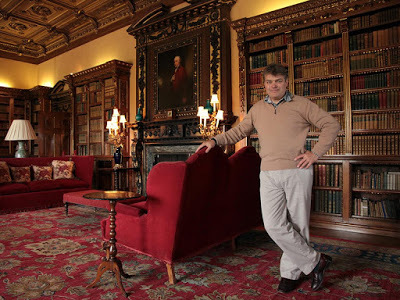 We rather expected the Earl of Canarvon to welcome us, but apparently he was urgently called away.
We rather expected the Earl of Canarvon to welcome us, but apparently he was urgently called away.(Photo of the library from the website)
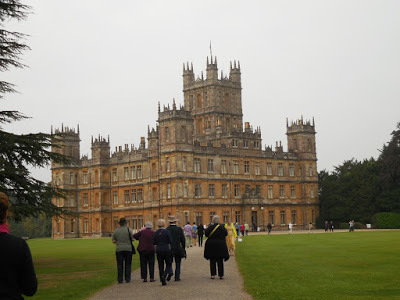 We were not alone, but it was not crowded. Tickets carefully controlled it seems.
We were not alone, but it was not crowded. Tickets carefully controlled it seems.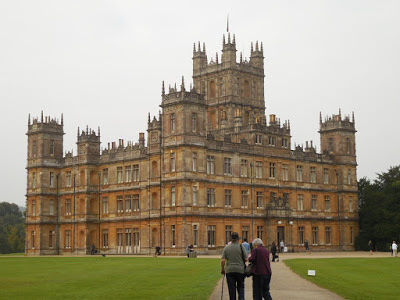 Can you ever get enough of the view of the castle -- all those Victorian Gothic points, notto mention it's sheer size.
Can you ever get enough of the view of the castle -- all those Victorian Gothic points, notto mention it's sheer size.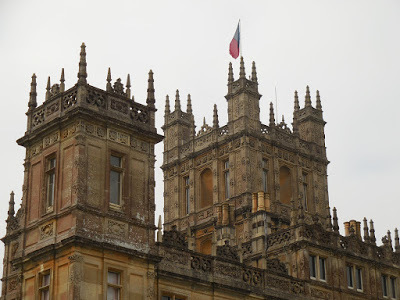 If it reminds you of the Houses of Parliament in London, blame the same architect, Sir Charles Barry
If it reminds you of the Houses of Parliament in London, blame the same architect, Sir Charles Barry Here are some views of the interior, from the web, as no pictures were allowed inside.
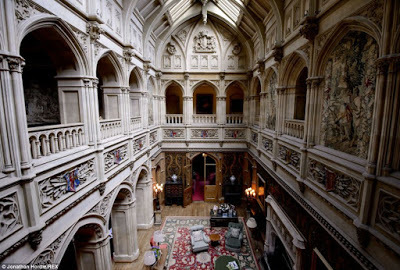 The Gallery
The Gallery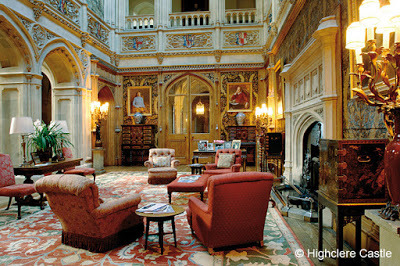 The Saloon
The Saloon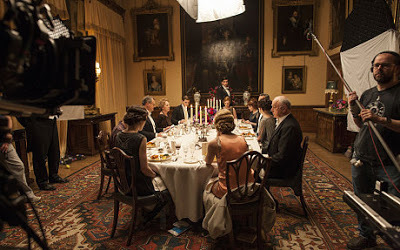 The Dining Room, in a scene from Downton Abbey
The Dining Room, in a scene from Downton Abbey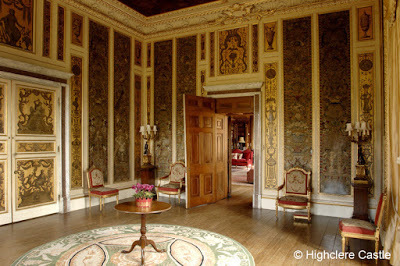 The Music Room
The Music RoomOUR PICTURES AGAIN...
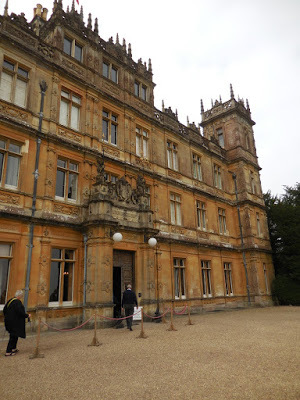 ABOVE AND BELOW, THE ENTRANCE
ABOVE AND BELOW, THE ENTRANCE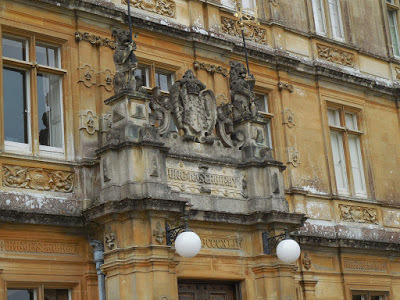
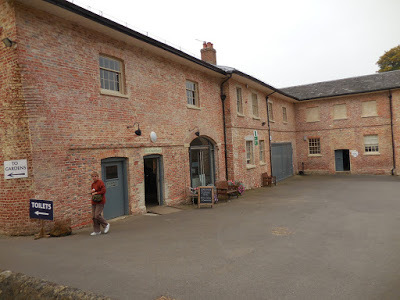
ABOVE AND BELOW, THE STABLE BLOCK, A.K.A. THE GIFT SHOP
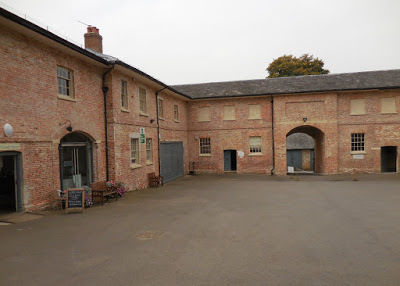
\
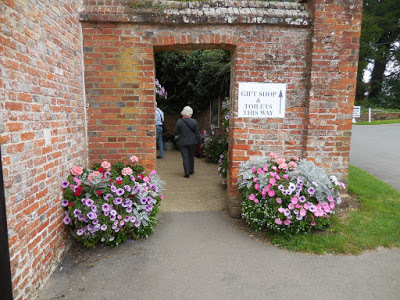
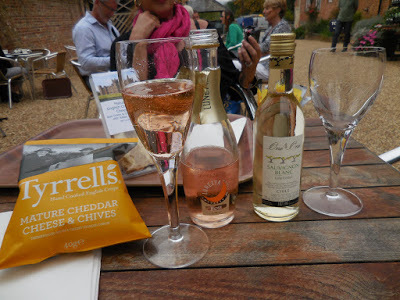 Always ready for a break for lunchViews of the Park
Always ready for a break for lunchViews of the Park The ubiquitous sheep
The ubiquitous sheep Heaven's Gate, A folly in the mist
Heaven's Gate, A folly in the mist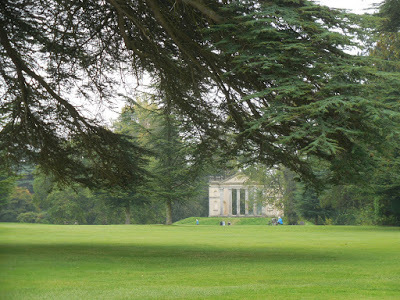 Starting the trek across the lawn to Jackdaws Castle
Starting the trek across the lawn to Jackdaws Castle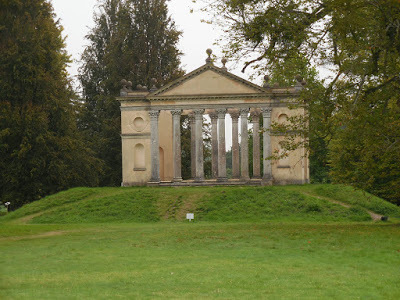
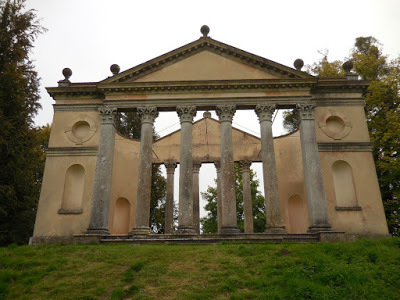 Jackdaws Castle was built in 1743 by Robert Herbert using Corinthian Columns from Berkeley House in London which burned down in 1733
Jackdaws Castle was built in 1743 by Robert Herbert using Corinthian Columns from Berkeley House in London which burned down in 1733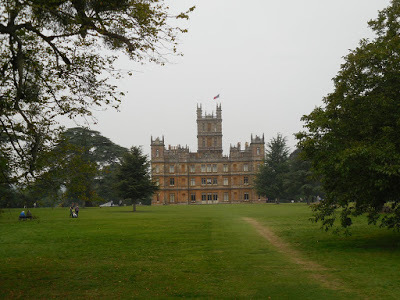 Highclere from Jackdaws
Highclere from Jackdaws One of the many graceful old cedar trees
One of the many graceful old cedar treesThe Gardens
 Hmmm...a warning
Hmmm...a warning Looks pretty harmless to me
Looks pretty harmless to me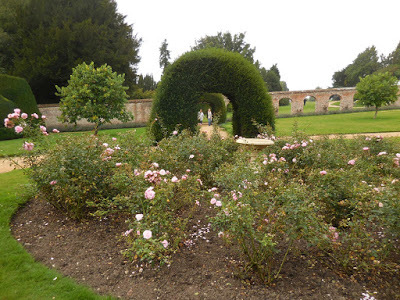
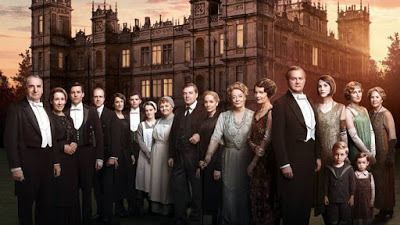
Recently we heard that the Queen is a fan of Downton Abbey, watching for little errors. Click here for the story.
Very soon, Downton will return on TV screens in the UK. On January 3, 2016, Downton Abbey returns to MASTERPIECE on PBS with its 6th and final season set in 1925.
For the Season 6 trailer, click here. Spoiler alert: It bodes ill!
For lots more information from PBS, click here.
Published on September 11, 2015 00:30
September 9, 2015
QUEEN ELIZABETH: LONGEST REIGNING BRITISH MONARCH
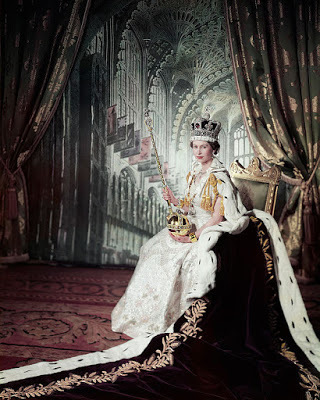 Coronation Day, 2 June 1953 Photo: Cecil Beaton/Royal Collection Trust/PA
Coronation Day, 2 June 1953 Photo: Cecil Beaton/Royal Collection Trust/PAThis is the day Elizabeth II becomes the longest reigning British monarch, surpassing the previous record of her great-great-grandmother Queen Victoria's 63 years, 216 days, give or take a few hours. Since the exact hour of King George VI's death in 1952 is not known, precise timing is inexact.
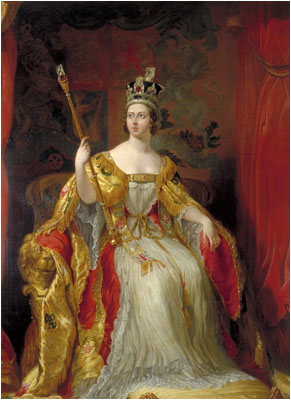 Victoria's Coronation Portrait by George Hayter, 1838
Victoria's Coronation Portrait by George Hayter, 1838Queen Victoria had surpassed her grandfather George III's record reign of 59 years, 96 days, though in the last nine of those years, he was incapacitated by mental illness, and royal power was in the hands of his son, the Prince Regent, later George IV.
Last week, the Daily Mail carried a story about the low-key nature of the event. Click here.
However, she is expected to temporarily leave Balmoral Castle where she is on holiday with her family to open the Scottish Borders Railway and ride a steam train. Otherwise, she will keep to her usual schedule of daily walks and rides, working on the Red Boxes, and enjoying her grand- and great-grandchildren.
 Photo: Royal Collection/PA
Photo: Royal Collection/PAThe Queen's milestone is not going unnoticed all over the world. Take a look at People Magazine';s coverage here.
The Queen has traveled more than any other monarch, making 265 Overseas Visits.
An interactive map is here.
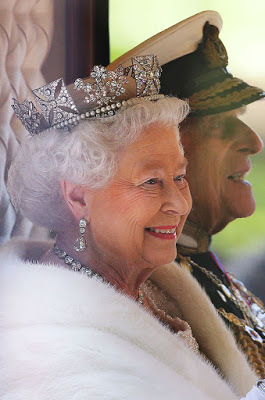 The Queen and the Duke of Edinburgh leaving for the State Opening of Parliament in London, 27 May 2015 Photo: Stephen Lock/i-Images/PA
The Queen and the Duke of Edinburgh leaving for the State Opening of Parliament in London, 27 May 2015 Photo: Stephen Lock/i-Images/PA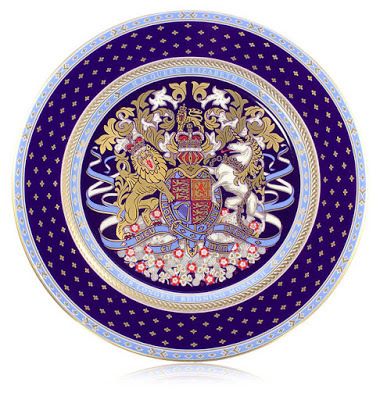 And it is another opportunity to acquire more souvenirs. Commemorative plates and other china articles are on sale at Royal Collection Trust shops and by mail. Photo: Royal Collection/PA
And it is another opportunity to acquire more souvenirs. Commemorative plates and other china articles are on sale at Royal Collection Trust shops and by mail. Photo: Royal Collection/PADisplays of memorable photographic portraits taken during the Queen's 63-year reign will go on display at Buckingham Palace, Windsor Castle and the Palace of Holyroodhouse today.
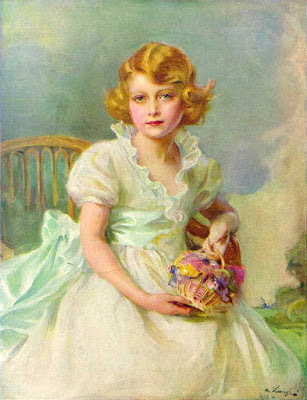 Princess Elizabeth of York, age 7, 1933by Philip de LaszloThis painting hangs in Clarence House
Princess Elizabeth of York, age 7, 1933by Philip de LaszloThis painting hangs in Clarence House The Queen at Royal Ascot a few years ago
The Queen at Royal Ascot a few years ago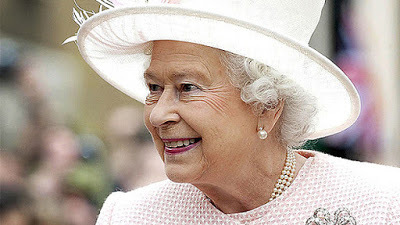 Another recent photo of Her Majesty
Another recent photo of Her Majesty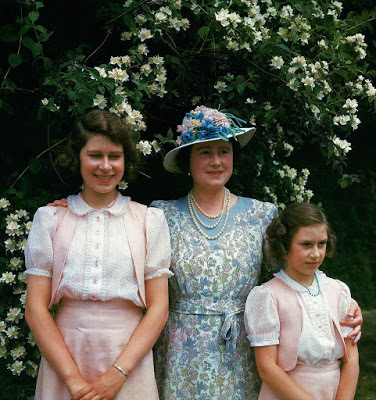 Princes Elizabeth, the Queen Mother, Princess Margaret, 1943
Princes Elizabeth, the Queen Mother, Princess Margaret, 1943Click here for pictures and commentary on the Queen as a Fashion Icon for sixty-plus years.
Here are a more few of the recent newspaper stories about the event:
Click here for the Queen's reign in one minute.
Click here for a story about the commemorative coin to be issued.
Click here for the secret of the Queen's success -- or one version of it anyway.
Click here for more on the china and the picture exhibition.
And click here for the Independent's take on the story.
Click here for a story from the Daily Express.
Click here for the Daily Mail.
AND MAY YOU REIGN FOR MANY MORE YEARS, YOUR MAJESTY!If you want to celebrate the longest reigning monarch, you can buy a tee shirt with this image. Click here.

Published on September 09, 2015 00:30
September 7, 2015
WELCOME GUEST BLOGGER, AWARD-WINNING AUTHOR KERRYN REID
Victoria here, delighted to welcome fellow SWFRW member Kerryn Reid for a guest blog. Her debut novel, LEARNING TO WALTZ,has been named Best Regency in the Chatelaine Awards for Romance Fiction, sponsored by Chanticleer Book Reviews, among other honors. Click here for her website.
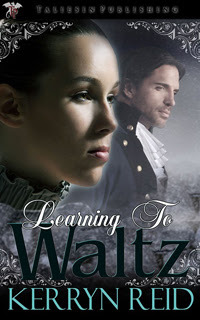
“Julian!” Deborah called, then whipped around and called again. The stitch in her side tore her ribs apart. Her skirts were wet to the thighs, tangling themselves around her knees and ankles. Her old boots, soaked and broken, scooped up dirt and pebbles from the road, making her stagger. Thankfully, her feet were numb – her bare hands too, torn by snags and brambles. Not that it mattered. If she didn’t find Julian, nothing would matter.
A lost child herself, Deborah Moore has learned her lessons well – feel nothing, reveal less, and trust no one. Now widowed with a child of her own, she leads a lonely, cloistered existence, counting her farthings and thinking she is safe. When five-year-old Julian is lost that bitter December day, she discovers how tenuous that safety is.
Evan Haverfield holds no title, but he’s aristocracy nonetheless. He has not seen a kitchen since he was a child. But his life changes when he finds Julian Moore half-frozen under a hedge and carries him home to his mother. This impecunious young widow cooks her own meals and scrubs her own doorstep – she will hardly be welcomed into his family. Yet this is the woman he wants.
As a modern Western woman, that kind of social stratification seems alien, even detestable. But it was a fact of life during the Regency. In fact, it’s one of the classic tropes of Regency romance. Why would I choose such a time to place my stories, when I enjoy reading historical fiction from many periods?
My mother loved to travel. She was also in love with the British Isles. Don’t ask me why; her heritage was German, as was my father’s. Neither of them spoke any language but English, however, which made English-speaking destinations more comfortable. Dad was a university professor, and with Mom at his back there was no way he’d be spending a sabbatical leave stateside!
 Dad and his three girls by the Chapel at Ashby de la Zouch Castle, Leicestershire, 1958-59I'm the little one!
Dad and his three girls by the Chapel at Ashby de la Zouch Castle, Leicestershire, 1958-59I'm the little one!There was Leicester, when I was three. In Dublin, I was a 12-year-old British-Invasion fanatic. By that time my parents had discovered British antiques and mystery writers. And that, I suspect, was how they found Georgette Heyer.
But they were broadminded enough to read and enjoy Heyer’s romances, too. (In fact, I think my father liked them more than Mom did.) I don’t remember when I read my first Heyer Regency, or which one it was. Suffice it to say, I spent my adolescence with Georgette Heyer. I was intimate (I wish!) with Lord Damerel and Dominic Vidal years before I read Emma in high school English class. I cringe to say, I found it boring. Can you imagine? It took another couple of years before I “got” Austen’s humor and devoured the remainder of her frustratingly brief bibliography. Then did it again, and again.
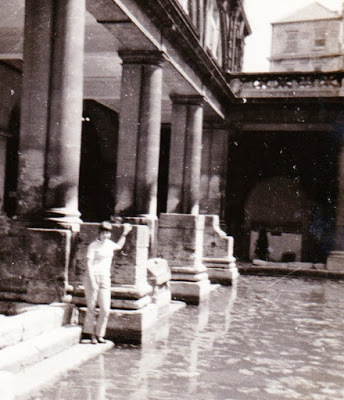 Visiting Bath, that essential Regency setting 1965-66
Visiting Bath, that essential Regency setting 1965-66By the time I’d read a zillion more Regencies by a thousand different authors, I figured I had a good handle on the tropes, the language, the social conventions. Writing one of my own should be easy, right?
Wrong, of course. There were a few unforeseen difficulties.
First of all, I didn’t know how to Write. Oh, I was good at putting words together, mostly into long, pretty, complex sentences. (Not as long, pretty and complex as Austen’s, but still.) Not until I finished the first draft of Learning to Waltz did I join a writing group and begin learning how I should have done it. Show, don’t tell. Start in the middle of crisis. Background is B-O-R-I-N-G. Who knew there were rules? (A year or so ago, I picked up Arabellaafter a long hiatus. I doubt Heyer would ever find a publisher if she were writing today. POV? All over the map. Dialogue tags? All kinds. Adverbs? Tons. No wonder my manuscript needed so much work, with Georgette as my teacher.)
I also had no idea what my Voice would sound like. Turns out it’s far different from Heyer’s, and I don’t think it’s quite like anyone else’s either. I do drama much better than humor, and surprised myself by writing some darn good dialogue. Who knew?
And then there’s that troubling little business called Research. It’s amazing how much I still don’t know about Regency life. Maybe I just didn’t pay attention to the details as I read all those novels. Did they hang bells by the front door, or use knockers, or just their knuckles? Sure they used candles, but how did they light them? What did they call the flu, or a cold, and how did they treat them? And very important for Learning to Waltz, how did they celebrate Christmas and New Year’s?
Like Austen’s, my stories are small. Intimate. A review from the Historical Novel Society said, “Reid excels at the slow, careful picture of two complex personalities learning each other’s nature.” I’m happiest delving into my characters’ hearts and revealing them to my readers.
In Deborah’s village in Leicestershire, they hold a ball on New Year’s Eve. But Deborah doesn’t come, and Evan escapes the festivities to berate her for denying him the dance he was counting on. Alone in her shadowed parlor, he teaches her to waltz. Yet that waltz is also a metaphor for all the other things Deborah must learn, like trust, and laughter, and how to deal with one very persistent man. And isn’t that what life is about? We are all learning to dance, one set of steps or another. For instance, I’m still learning to write. As I work on my next Regency, I’m still learning the secrets of this new cast of characters and the details of their lives.
I’m also groping my way through social media and the business of promotion. What, for instance, should I do with this fabulous award from Chanticleer Book Reviews? For one thing, I’ll write guest posts for fabulous friends like Victoria!
Finally (for the moment), I’m having a blast with my monthly newsletter, Seasons of the Past. Focusing on seasonal and holiday customs past and present, with a particular interest in the Regency, it offers history, recipes, excerpts, personal photos and more. You can find subscription forms on my website here.
and Facebook page, here.
THANK YOU, KERRYN! ENJOY EVERY MOMENT OF YOUR SUCCESS!
Published on September 07, 2015 00:30
September 3, 2015
THE DUKE OF WELLINGTON TOUR: WHAT KRISTINE SAW FROM THE COACH WINDOW: DOVER TO BRIGHTON
Published on September 03, 2015 23:30
September 2, 2015
DINNER WITH THE DUKE OF WELLINGTON
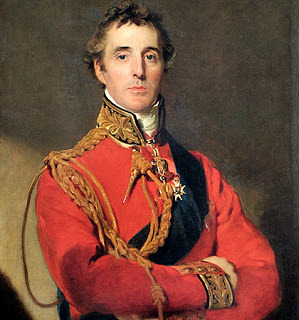
On November 19, 2015, I shall be dining with the Duke of Wellington in Philadelphia. I say this to people - people I know but who aren't au fait with British history - and in response, they look at me askance whilst uttering a nervous laugh. "Right," they say, "the Duke of, er, whatever. Right. Nice. So, er, I'm just going to go and . . . . ." They think I'm nuts. I say the same thing to people who are on point as far as British history is concerned and they say, "Oh, you're a card! The Duke of Wellington. Right! Har Har!" Followed again, for the most part, by nervous laughter.
As though I would lie about the Duke of Wellington. Me. Lie about the Duke. I ask you!? Okay, so I won't be dining with that Duke, but rather this Duke - Charles Wellesley, the 9th Duke of Wellington.

And whilst I'll be dining with the Duke, so will about one hundred others. Honestly, here's the link to the event, which is actually a lecture by the Duke followed by dinner. Victoria was otherwise engaged, so I roped Hubby into agreeing to travel to Philadelphia and attend the event with me. Now you can cue the nervous laughter.
Tickets to the event have been secured. Flights booked. Hotel room the same. Done and dusted. Now all that's left to worry about is the night itself. Many people have dined with many Dukes of Wellington and, as far as I know, all of them have survived. Mrs. Arbuthnot and Lady Shelley dined with the first Duke many times and they came out alright. Queens and Kings have dined with subsequent Dukes of Wellington and emerged unscathed. It's not the dining, or even the minute long meeting, with the Duke of Wellington that concerns me. Well, okay, Hubby meeting the Duke of Wellington does concern me, but personally I'm in a quandry as to what to wear. What does one wear to meet the Duke of Wellington? Or any Duke, for that matter. The event details say, "Formal Business Attire." I can understand this as far as men are concerned, but what about women? Surely something more than a severe skirt and jacket is warranted for an evening event with the Duke?
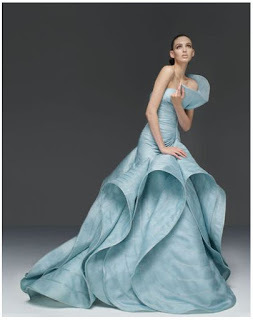
Granted, this might be a tad too much . . . . . .

But on the other hand, surely this is too little?

Is this more like it? Or am I still off base?

I suppose I could always follow the Royal lead . . . . . but then I'd have to find a hat. Sigh.
What to wear, what to wear? It's a quandry and it's distracting. So distracting, in fact, that I'm not even worrying about how in the world I'm going to get Hubby into anything resembling "formal business attire."
Please do leave a comment as to proper attire. I'd welcome the input. Hints, tips and tricks on how to get Hubby to agree to don a suit and tie when no one he knows has died would be likewise appreciated.
Published on September 02, 2015 07:26
Kristine Hughes's Blog
- Kristine Hughes's profile
- 6 followers
Kristine Hughes isn't a Goodreads Author
(yet),
but they
do have a blog,
so here are some recent posts imported from
their feed.



























